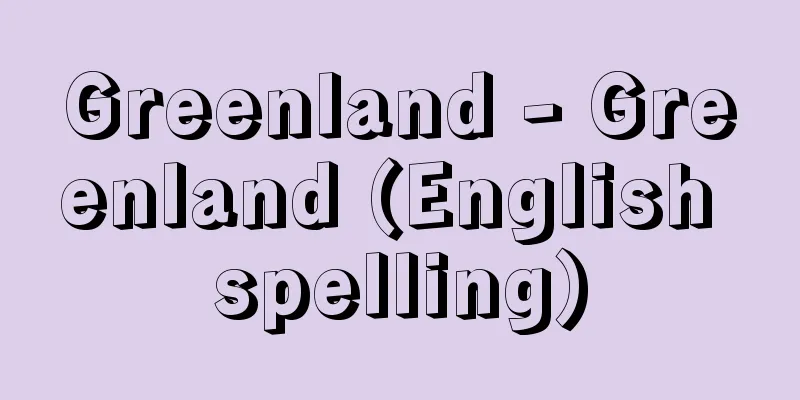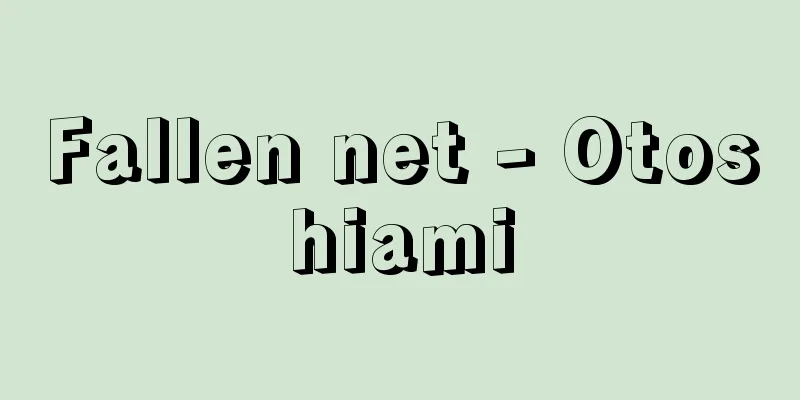Greenland - Greenland (English spelling)

|
The world's largest island, located northeast of the North American continent. It has an area of 2,166,086 square kilometers and a population of 56,542 (2002). It is a territory of Denmark, but like the Faroe Islands of Denmark, it gained self-government in 1979. Administratively, it is divided into North, West and East Greenland, with its capital at Gothave (Nuuk). From its northernmost point, Cape Morris Jesup (latitude 83°39′N), to its southernmost point, Cape Farewell, it is 2,670 kilometers long, with most of it located within the Arctic Circle. It borders the Arctic Ocean to the north, the Greenland Sea, Denmark Strait and the North Atlantic to the east, and Davis Strait, Baffin Bay and Robson Strait (26 kilometers at its narrowest point) to the west, and faces the Canadian Arctic Islands. [Hiroshi Kusunoki] NatureThe ice sheet and glaciers cover 1.8 million square kilometers, or about 80% of the island. The ice sheet fills the center of the cup-shaped island, with an average ice thickness of about 1,500 meters and a maximum of 4,000 meters. The highest point of the ice sheet is 3,200 meters, and the altitude decreases toward the coast, where there are many exposed rock areas, fjords (narrow bays), and numerous islands. In the eastern part of the ice sheet, there are exposed rocks (nunataks), and the highest peak is Mount Gunnbjørn (3,700 meters). Geologically, Greenland belongs to the Canadian Shield (Laurentian Plateau) and is made of Precambrian gneiss and granite. However, Peary Land in the north belongs to the Palaeozoic Caledonian orogen, and the surrounding exposed rock areas show traces of Cretaceous upheaval (coal on Disko Island) and Palaeogene volcanic activity (approximately 50 million years ago). Hot springs and geothermal areas can be found in Liverpool Land on the east coast and Juliane Hope on the west coast. Iron meteorite fall sites are scattered around Melville Bay in the northwest, and in 1897 American Peary's Arctic Expedition carried the largest meteorite weighing 31 tons (the Anigito meteorite) to New York. Greenland has a cold climate, with the Gulf Stream (Gulf of Mexico) slightly influencing the southwestern coast. The annual average temperature inside the ice sheet reaches -30°C. At the northernmost Nord weather station, the annual average temperature is -17.4°C, and the annual precipitation (mainly snowfall) is 350 mm. At Goat Hope, the annual average temperature is -0.7°C (-7.3°C in the coldest month, 6.7°C in the warmest month), and the annual precipitation is 800 mm. At the southern tip (about 60°N), the average temperature reaches 1800 mm, but snowfall occurs even in summer. Since the beginning of the 20th century, the climate has warmed, and as a result, seals have migrated north, and cod stocks have increased. However, since the end of the 1960s, seawater temperatures have dropped, and cod fishing has dropped sharply. The flora consists of mosses and lichens in the north, but also birch, willows and other shrubs in the south, totalling 400 species. Potatoes and hay (sheep feed) are grown in the southern tip, while turnips, cabbage and lettuce are cultivated on the southwestern coast. The sea is rich in animals, providing a food source for the Greenlanders (the indigenous people). Cold-water fish include salmon, trout, cod, flounder, halibut and shrimp. Seals and whales are also found, although their numbers have declined dramatically. On land, polar bears, musk oxen, reindeer (some of which are kept captive), arctic foxes, arctic hares and lemmings can be found. There are also many birds, some of which are used as food by the indigenous people. Mosquitoes thrive in the summer. [Hiroshi Kusunoki] historyIn the northeast, there are ruins dating back 4000 years to the Inuit who migrated from the far north of Canada. At the end of the 10th century, Norman Erik the Red and his party migrated to Julianehope, and the population of the colony reached 3000 at one time, but disappeared around the 16th and 17th centuries. European whalers came into contact with the Inuit, and in 1721, Norwegian Christian missions began. Denmark took the lead in trade, strengthening its colonial control over Greenland, and a dispute over sovereignty with Norway ensued, but was resolved in 1933. The United States fought back against Germany's invasion of Greenland during World War II, and Greenland's value as a transit point for transporting goods to Europe increased. After the war, air force and radar bases were established in Greenland as part of the US strategy against the Soviet Union. [Hiroshi Kusunoki] industryThe main industry is fishing, with cod, shrimp, halibut, etc. (total catch in 1997 was 120,596 tons). Trading is mainly done by the Royal Greenland Trading Company (abbreviated as KGH) (privatized in 1990), but there is a tendency for private companies to take over. Products include seal and fox skins, as well as lead and zinc minerals. About 22,000 sheep (2000) and about 3,800 reindeer are also kept. Total exports of marine and mineral products are about 1,702 million kroner, while total imports were about 2,740 million kroner (1998), resulting in a trade deficit. Most of the trade is with Denmark. In recent years, the number of people travelling by air has increased (about 70,000 people per year), while the number of people travelling by ship is 47,000. Scandinavian Airlines has opened an air route between Copenhagen and Kangerlussuaq. Direct access from North America is not permitted. Although mining is in decline, exploration for oil, uranium, chromium, iron, etc. continues, and in recent years international capital has been introduced, drawing international attention. [Hiroshi Kusunoki] residentsOf the population, there are 41,000 Greenlanders, indigenous people with mixed Danish and other ethnicities, 9,000 white settlers, and 1,900 workers at the weather station and other facilities. Most of the population lives in the towns and villages in the western region, with only about 10,000 people living in scattered settlements. After the Second World War, Greenland became more modern in both social and economic terms, with 24,600 telephone lines (1998) and 3,874 passenger cars (including trucks) (1998). There are 1,047 kindergarten and primary school teachers (1998), and 84 doctors (1998). There is a disparity in income between Greenlanders and white settlers (annual income of 8,000 kroner for married Greenlanders and 19,000 kroner for married White settlers), which is becoming a social problem. The Home Rule Act enacted in 1979 has given Greenlanders a stronger say. However, their economic base is weak and many problems remain. [Hiroshi Kusunoki] A referendum in 2008 supported greater autonomy, and the Autonomy Act was amended in 2009 to give the autonomous government authority over all matters except foreign affairs and security. [Editorial Department] Relations with JapanAlthough the relationship is not very close, Japanese products are also being sold in Greenland. The number of Japanese people visiting Greenland for exploration, mountaineering, and sightseeing is increasing, and in 1978, Uemura Naomi made a solo dog sled trip from north to south. For several years from 1956, Nakaya Ukichiro studied snow on the ice sheet. [Hiroshi Kusunoki] World Heritage RegistrationThe glacier in Ilulissat, a town on the west coast of Greenland, was registered as a natural World Heritage Site by UNESCO (United Nations Educational, Scientific and Cultural Organization) as the "Ilulissat Icefjord" in 2004 (World Natural Heritage Site). In 2017 and 2018, Inuit ruins were registered as a cultural World Heritage Site (World Cultural Heritage Site). [Editorial Department] Source: Shogakukan Encyclopedia Nipponica About Encyclopedia Nipponica Information | Legend |
|
北アメリカ大陸の北東にある世界最大の島。面積216万6086平方キロメートル、人口5万6542(2002)。デンマーク領であるが、同国のフェロー諸島と同じく、1979年に自治権を得た。行政上、北、西、東グリーンランドに分かれ、中心地はゴートホープ(ヌークNuuk)。最北端のモリス・ジェサップ岬(北緯83度39分)から南端のフェアウェル岬まで2670キロメートル、大部分が北極圏内にある。北は北極海、東はグリーンランド海、デンマーク海峡、北大西洋に面する。西はデービス海峡、バフィン湾、ロブソン海峡(最狭部26キロメートル)で、カナダ北極海諸島に対する。 [楠 宏] 自然全島の約80%にあたる180万平方キロメートルは、氷床や氷河で占められる。氷床は茶碗(ちゃわん)形の島の中心部を満たし、平均氷厚約1500メートル、最大4000メートルに達する。氷床の最高点は3200メートルで、海岸に向かって高度が下がり、沿岸部は露岩地帯が多く、フィヨルド(峡湾)や多数の島がある。東部の氷床上には露岩が突出し(ヌナタク)、最高峰はギュンビョルン山Mount Gunnbjørn(3700メートル)。グリーンランドは、地質構造上、カナダ楯状地(たてじょうち)(ローレンシア台地)に属し、先カンブリア時代の片麻(へんま)岩や花崗(かこう)岩からなる。しかし、北部のペアリーランドは古生代のカレドニア造山帯に属し、周囲の露岩地帯には、白亜紀の変動(ディスコ島の石炭)や、古第三紀(約5000万年前)の火山活動の跡がみられる。東岸のリバプール・ランドや西岸のユリアネホープなどには温泉や地熱地帯がある。北西部のメルビル湾付近に鉄隕石(いんせき)の落下地点が散在し、1897年にアメリカ人ペアリーの北極探検隊が、最大31トンのもの(アニギト隕石)をニューヨークへ運んだ。 グリーンランドの気候は寒冷で、わずかに南西岸がガルフストリーム(メキシコ湾流)の影響下にある。氷床内部の年平均気温は、零下30℃に達する。最北部のノルド測候所の年平均気温は零下17.4℃、年降水量(おもに降雪による)は350ミリメートル。ゴートホープは年平均気温零下0.7℃(最寒月零下7.3℃、最暖月6.7℃)、年降水量800ミリメートル。南端(北緯約60度)では1800ミリメートルに達するが、夏でも降雪をみる。20世紀の初めから気候が温暖化し、これに伴ってアザラシが北へ移動し、タラの資源量が増えた。しかし、1960年代の終わりから海水温度が下がり、タラ漁が激減した。 植物相は、北部ではコケや地衣類などであるが、南部ではカバ、ヤナギなどの低木もあり、総数400種に及ぶ。南端部ではジャガイモや干し草(ヒツジ飼料)がつくられ、南西岸ではカブ、キャベツ、レタスが栽培されている。海には動物が豊富で、グリーンランダー(先住民)の食糧源となっている。魚類はサケ、マス、タラ、ヒラメ、オヒョウ、エビなど、寒流系のものがとれる。アザラシ、クジラもいるが、クジラは激減した。陸にはホッキョクグマ、ジャコウウシ、トナカイ(一部は飼育)、ホッキョクギツネ、ホッキョクウサギ、レミングなどがいる。鳥類も多く、なかには先住民の食糧となるものもある。夏には蚊(か)が多く発生する。 [楠 宏] 歴史北東部に、カナダ極北部から移動してきたイヌイットの4000年以前の遺跡がある。10世紀末に、ノルマン人エリックErik the Red一行がユリアネホープへ移住し、植民地の人口は一時3000人に及んだが、16、17世紀ごろには消滅した。その後ヨーロッパの捕鯨業者がイヌイットと接触し、1721年にノルウェーのキリスト教伝道が始まった。デンマークが交易の主導権をとり、グリーンランドの植民地支配が強まり、ノルウェーとの主権争いが続いたが、1933年に解決した。第二次世界大戦によるドイツのグリーンランド侵入に対し、アメリカが反撃にあたり、ヨーロッパへの物資輸送のための中継地としてグリーンランドの価値が高まった。大戦後は、アメリカの対ソ戦略上、グリーンランドに空軍基地やレーダー基地が置かれるようになった。 [楠 宏] 産業主産業は漁業で、タラ、エビ、オヒョウなどがとれる(1997年総漁獲高12万0596トン)。売買はKGHと略称される王立グリーンランド交易公社(1990年に民営化)が中心となっているが、私企業によるものが増える傾向にある。生産物には、アザラシやキツネの皮のほか、鉛や亜鉛の鉱産物もある。ヒツジ約2万2000頭(2000)やトナカイ(約3800頭)の飼育も行われている。水産物や鉱産物などの総輸出額は約17億0200万クローネ、総輸入額は約27億4000万クローネ(1998)と輸入超過である。おもにデンマーク本国との取引が多い。出入国者は、近年、航空機利用者が増え(年間約7万人)、船の利用者は4.7万人である。スカンジナビア航空が、コペンハーゲンとカンゲルルススアーク間に航空路を開いている。北アメリカからの直接乗り入れは許されていない。鉱業は衰退しているが、石油、ウラン、クロム、鉄などの探査が続けられており、近年は国際資本も導入され、国際的に注目されている。 [楠 宏] 住民住民のうち、グリーンランダーとよばれる先住民およびデンマーク人などとの混血者が4.1万人、白人移住者は9000人となっているが、このほかに測候所などの勤務者1900人がいる。大部分は西部地区の町村に住み、点在する集落には約1万人が住んでいるにすぎない。第二次世界大戦後、社会、経済面で近代化が進み、グリーンランド全体で電話回線数2万4600(1998)、乗用車保有台数(トラック等含む)3874台(1998)を数える。幼・小学校の教員数は1047人(1998)、医師は84人(1998)である。グリーンランダーと白人移住者との間には収入の差があり(既婚者で年収8000クローネと1万9000クローネ)、社会問題となりつつある。1979年に制定された自治法(ホーム・ルール)により、グリーンランダーの発言力は強まりつつある。しかし、彼らの経済基盤が弱く、多くの問題が残されている。 [楠 宏] 2008年の国民投票で自治拡大が支持され、2009年に自治法が改正、外交と安全保障を除いた権限を自治政府がもっている。 [編集部] 日本との関係関係は密接ではないが、日本製商品はグリーンランドにも進出している。探検、登山、観光で訪れる日本人も増えつつあり、1978年には植村直己(うえむらなおみ)が南北縦断の単独犬ぞり旅行を行った。1956年から数年、中谷宇吉郎(なかやうきちろう)が氷床の雪の研究を行った。 [楠 宏] 世界遺産の登録グリーンランド西岸の町イルリサットにある氷河が2004年、ユネスコ(国連教育科学文化機関)により「イルリサット・アイスフィヨルド」として世界遺産の自然遺産に登録された(世界自然遺産)。また、2017、2018年に、イヌイットの遺跡が世界遺産の文化遺産に登録されている(世界文化遺産)。 [編集部] 出典 小学館 日本大百科全書(ニッポニカ)日本大百科全書(ニッポニカ)について 情報 | 凡例 |
>>: Grimmelshausen - Hans Jakob Christoffel von Grimmelshausen
Recommend
Rapid eye movement - Rapid eye movement
… REM sleep alternates with non-REM sleep at appr...
Return to bloom - Kaerizaki
…It is also called a return flowering. Different ...
Ars gallica (English spelling)
…On the other hand, Saint-Saëns was a promoter of...
Achromat - Achromat
Please see the "Achromatic Lenses" page...
Pevsner, Sir Nikolaus
Born: January 30, 1902 in Leipzig [Died] August 18...
Pascal
[1] (Blaise Pascal) French thinker, mathematician,...
Yunotsuru [Hot Spring] - Yunotsuru
A hot spring in the southwest of Kumamoto Prefectu...
One-minute money
A rectangular gold coin from the Edo period. It is...
Maxillacaste
…The etymology of the genus name is maxilla, deri...
Scabiosa
...An annual plant of the family Diapalaceae that...
Central scotoma
…In the later stages of retinitis pigmentosa and ...
Council of Chalcedon - Chalcedonian Council
The Fourth Ecumenical Council was held in Chalcedo...
Iji Castle
The remains of a Nara period castle and government...
Charles Du Bos
1882‐1939 French critic. Born into an upper-class ...
idiophones
...For this reason, when classifying musical inst...








![Jungfrau [mountain] - Jungfrau](/upload/images/67cd15f0630a7.webp)
